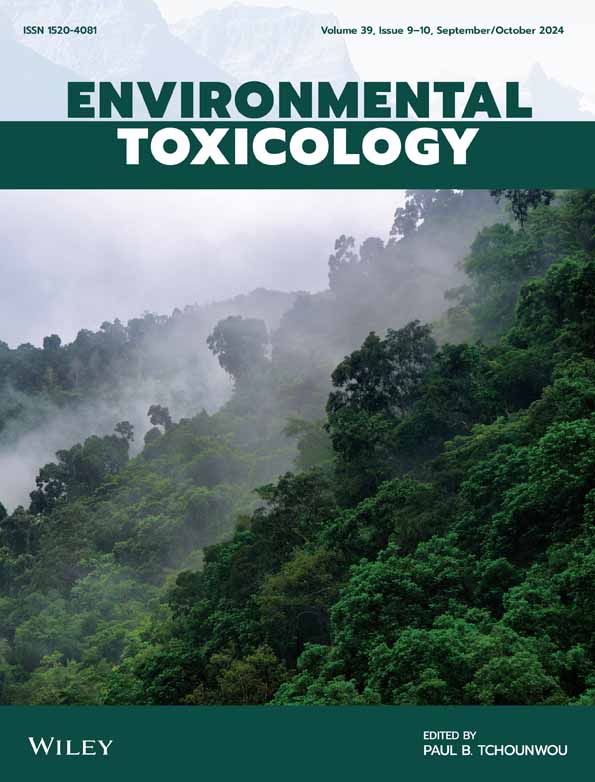Aglaia elliptifolia Leaf Extract Inhibits Autophagy‐Related 4B Protease and Suppresses Malignancies of Colorectal Cancer Cells
IF 4.4
3区 医学
Q2 ENVIRONMENTAL SCIENCES
引用次数: 0
Abstract
Autophagy is a self‐eating pathway for maintaining normal cellular physiology, while dysregulation of autophagy is associated with cancer progression. Autophagy‐related 4B gene (ATG4B) is a cysteine protease to regulate autophagosome formation and is positively correlated with poor prognosis of colorectal cancer (CRC) patients. An increasing number of reports have implied that ATG4B might be an attractive drug target for CRC. Natural products are the most important source of drug development for cancer therapy due to their high degree of diversity in chemical structure. However, there are few natural products targeting autophagy regulation, especially targeting ATG4B. We aim to identify effective natural compounds from costal plants against ATG4B as potential CRC therapies. We extracted the whole plants, stem, and leaves from nine coastal plant species of Taiwan using different solvents including acetone, methanol, or chloroform. We then evaluated their effects on ATG4B activity and cancer malignancy in CRC cells (DLD‐1, HCT116, and SW620). Among these 26 extracts, we found that the methanol leaf extract of椭圆木叶提取物能抑制自噬相关 4B 蛋白酶并抑制结直肠癌细胞恶变
自噬是维持细胞正常生理功能的自噬途径,而自噬失调则与癌症进展有关。自噬相关 4B 基因(ATG4B)是一种调节自噬体形成的半胱氨酸蛋白酶,与结直肠癌(CRC)患者的不良预后呈正相关。越来越多的报道表明,ATG4B 可能是治疗 CRC 的一个有吸引力的药物靶点。天然产物因其化学结构的高度多样性而成为癌症治疗药物开发的最重要来源。然而,针对自噬调控,尤其是针对 ATG4B 的天然产物却很少。我们旨在从木本植物中发现针对 ATG4B 的有效天然化合物,作为潜在的 CRC 治疗药物。我们使用丙酮、甲醇或氯仿等不同溶剂提取了九种台湾沿海植物的全株、茎和叶。然后,我们评估了它们对 ATG4B 活性和 CRC 细胞(DLD-1、HCT116 和 SW620)中癌症恶性程度的影响。在这 26 种提取物中,我们发现椭圆叶甲醇叶提取物能显著抑制 ATG4B 蛋白水解活性。此外,用该提取物处理的 CRC 细胞的存活率、集落形成和移动性均有所下降。鞣花提取物进一步减少了活细胞的数量,并诱导了 CRC 细胞的亚 G1 比例。椭圆叶提取物的细胞毒性在饥饿状态下的 CRC 细胞中也有所增强,而在 ATG4B 或自噬缺陷细胞中则没有额外的影响。综上所述,椭圆叶甲醇叶提取物可能含有生物活性化合物,可抑制ATG4B和自噬活性,从而降低CRC细胞的存活率和移动性,这表明它具有作为抗CRC药物开发的潜力。
本文章由计算机程序翻译,如有差异,请以英文原文为准。
求助全文
约1分钟内获得全文
求助全文
来源期刊

Environmental Toxicology
环境科学-毒理学
CiteScore
7.10
自引率
8.90%
发文量
261
审稿时长
4.5 months
期刊介绍:
The journal publishes in the areas of toxicity and toxicology of environmental pollutants in air, dust, sediment, soil and water, and natural toxins in the environment.Of particular interest are:
Toxic or biologically disruptive impacts of anthropogenic chemicals such as pharmaceuticals, industrial organics, agricultural chemicals, and by-products such as chlorinated compounds from water disinfection and waste incineration;
Natural toxins and their impacts;
Biotransformation and metabolism of toxigenic compounds, food chains for toxin accumulation or biodegradation;
Assays of toxicity, endocrine disruption, mutagenicity, carcinogenicity, ecosystem impact and health hazard;
Environmental and public health risk assessment, environmental guidelines, environmental policy for toxicants.
 求助内容:
求助内容: 应助结果提醒方式:
应助结果提醒方式:


